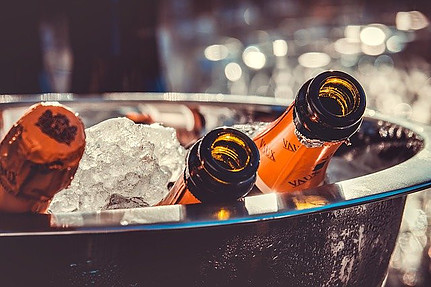Remembering that champagne is best consumed chilled, many put a bottle of drink in the freezer and forget it. But did you ever ask yourself, does champagne freeze, and at what temperature, and how to defrost a sparkling drink? Of course, it can freeze. As a result, sparkling wine turns into a block of ice because even strong alcoholic beverages can freeze when certain temperatures are reached. What to do with frozen champagne, and is it possible to drink it?
Does Champagne Freeze, and at What Temperature?
The approximate freezing temperature can be calculated using a simple formula: divide the alcohol strength by two and subtract one from the results.
At what temperature does that alcohol freeze in the bottle? The champagne production technology implies that the finished product’s alcohol content will be from 5 to 18 degrees. Therefore, the lightest version of this drink can be frozen at a temperature of -1.5 degrees.
In practice, most of the champagne that can be found on sale has a strength of 10 – 13 degrees. Therefore it is generally accepted that the drink begins to freeze at 5 degrees with a minus sign.
How to Defrost the Champagne?
What to do if the champagne is frozen, and how to defrost it quickly? The main thing is not to put a cold bottle in hot water and not put it in a water bath.
Defrosting champagne is a long-term process that requires gradual and uniform heating. To safely defrost a carbonated beverage, several consecutive steps must be taken:
- Move the product from a cold place to a warmer one. The best solution is to put the bottle on the shelf in the refrigerator, which will avoid a sudden drop in temperature.
- After about two hours, move the champagne to a dark and cooler place, warmer than the refrigerator (with a temperature of +1 to 15).
- Wait until the ice has melted in half, then place the bottle in a dark place with room conditions (+24 – +26 degrees). After approximately 30 to 40 minutes, the champagne will be ready to drink.
Pay special attention to the summer months, when the room thermometer’s mark can rise above 30 degrees. In this case, heat the drink only in dark, cool rooms so that the intense heat could not negatively affect the champagne’s taste and aroma.
The gradualness and precision of the process during thawing will restore the tasting characteristics champagne had before freezing.
How Not Defrost the Champagne?
Following the tips for defrosting champagne, you should not forget about precautions:
- Do not open the beverage bottle until all the ice has melted. If this is done prematurely, there is a risk of cold burns or injuries from sharp pieces of ice.
- Under no circumstances should you defrost champagne under a stream of warm water. With the shock, a sudden increase in the volume of carbon dioxide, and the bottle can explode.
- If there is no time to defrost a fizzy drink properly, and the bottle is frozen, then the best option would be to go to the store for a new one. This saves you time and health.
If the champagne is frozen, can I drink it after thawing? One of the negative consequences consumers fear is the deterioration or complete loss of champagne’s properties and characteristics after freezing. Some people think that sparkling wine loses its taste and aroma. In fact, unlike other varieties of wine, the structure of quality champagne does not suffer from exposure to low temperatures.
Accidentally overheated sparkling wine does not bother you – you need to give it time to return to its original state. By applying the rules of thawing, it becomes possible not only to preserve the structure of champagne but also to enjoy a refined drink’s original taste and aroma.
